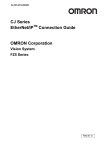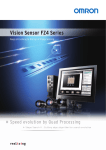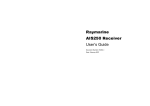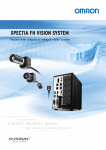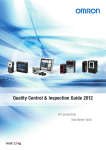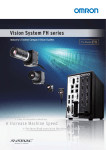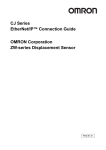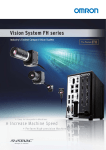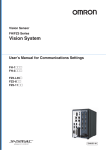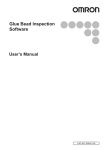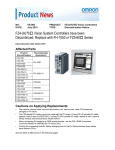Download CJ Series EtherNet/IPTM Connection Guide Vision System FH Series
Transcript
No.FST-ZTH130075A CJ Series EtherNet/IPTM Connection Guide OMRON Corporation Vision System FH Series P575-E1-01 About Intellectual Property Rights and Trademarks Microsoft product screen shots reprinted with permission from Microsoft Corporation. Windows is a registered trademark of Microsoft Corporation in the USA and other countries. ODVA and EtherNet/IPTM are trademarks of ODVA. Company names and product names in this document are the trademarks or registered trademarks of their respective companies. Table of Contents 1. Related Manuals ........................................................................................ 1 2. Terms and Definitions ............................................................................... 2 3. Precautions ................................................................................................ 3 4. Overview .................................................................................................... 4 5. Applicable Devices and Device Configuration ....................................... 5 6. 7. 8. 9. 5.1. Applicable Devices ............................................................................. 5 5.2. Device Configuration .......................................................................... 6 EtherNet/IP Settings .................................................................................. 8 6.1. EtherNet/IP Communications Parameters ......................................... 8 6.2. Allocating the Tag Data Links ............................................................. 8 EtherNet/IP Connection Procedure ........................................................ 10 7.1. Work Flow ........................................................................................ 10 7.2. Setting Up the FH Sensor Controller ................................................. 11 7.3. Setting Up the PLC .......................................................................... 16 7.4. Setting Up the Network .................................................................... 26 7.5. Checking the EtherNet/IP Communications ..................................... 38 Initialization Method ................................................................................ 43 8.1. Initializing the PLC ........................................................................... 43 8.2. Initializing the FH Sensor Controller ................................................. 44 Revision History ...................................................................................... 45 1.Related Manuals 1. Related Manuals The table below lists the manuals related to this document. To ensure system safety, make sure to always read and heed the information provided in all Safety Precautions, Precautions for Safe Use, and Precaution for Correct Use of manuals for each device which is used in the system. Cat. No. W472 Model CJ2H-CPU6[]-EIP Manual name CJ-series CJ2 CPU Unit Hardware User's Manual CJ2H-CPU6[] CJ2M-CPU[][] W473 CJ2H-CPU6[]-EIP CJ-series CJ2 CPU Unit Software User's Manual CJ2H-CPU6[] CJ2M-CPU[][] W465 CJ1W-EIP21 EtherNet/IPTM Unit Operation Manual CJ2H-CPU6[]-EIP W446 CJ2M-CPU3[] - CX-Programmer Operation Manual 2285550-0 FH-1[][][]/3[][][] Image Processing System Instruction Sheet Z340 FH-1[][][]/3[][][] Vision Sensor FH/FZ5 Series Vision System User's Manual Z341 FH-1[][][]/3[][][] Vision Sensor FH/FZ5 Series Vision System Processing Item Function Reference Manual Z342 FH-1[][][]/3[][][] Vision Sensor FH/FZ5 Series Vision System User's Manual (Communications Settings) 1 2.Terms and Definitions 2. Terms and Definitions Term Node Explanation and Definition Controllers and devices are connected to the EtherNet/IP network via the EtherNet/IP ports. The EtherNet/IP recognizes each EtherNet/IP port connected to the network as one node. When a device with two EtherNet/IP ports is connected to the EtherNet/IP network, the EtherNet/IP recognizes this device as two nodes. The EtherNet/IP achieves the communications between controllers or the communications between controllers and devices by exchanging data between these nodes connected to the network. Tag A minimum unit of the data that is exchanged on the EtherNet/IP network is called a tag. The tag is defined as a network variable or as a physical address, and it is allocated to the memory area of each device. Tag set In the EtherNet/IP network, a data unit that consists of two or more tags can be exchanged. The data unit consisting of two or more tags for the data exchange is called a tag set. Up to eight tags can be configured per tag set for OMRON controllers. Tag data link In the EtherNet/IP, the tag and tag set can be exchanged cyclically between nodes without using the user program. This standard feature on the EtherNet/IP is called a tag data link. Connection A connection is used to exchange data as a unit within which data concurrency is maintained. The connection consists of tags or tag sets. Creating the concurrent tag data link between the specified nodes is called a "connection establishment". When the connection is established, the tags or tag sets that configure the connection are exchanged between the specified nodes concurrently. Originator and To perform tag data links, one node requests the opening of a Target communications line called a "connection". The node that requests opening the connection is called an "originator", and the node that receives the request is called a "target". Tag data link The tag data link parameter is the setting data to perform the tag data parameter link. It includes the data to set tags, tag sets, and connections. 2 3.Precautions 3. Precautions (1) Understand the specifications of devices which are used in the system. Allow some margin for ratings and performance. Provide safety measures, such as installing safety circuit in order to ensure safety and minimize risks of abnormal occurrence. (2) To ensure system safety, always read and heed the information provided in all Safety Precautions, Precautions for Safe Use, and Precaution for Correct Use of manuals for each device used in the system. (3) The user is encouraged to confirm the standards and regulations that the system must conform to. (4) It is prohibited to copy, to reproduce, and to distribute a part or the whole of this document without the permission of OMRON Corporation. (5) The information contained in this document is current as of December 2013. It is subject to change without notice for improvement. The following notation is used in this document. Indicates a potentially hazardous situation which, if not avoided, may result in minor or moderate injury or in property damage. Precautions for Safe Use Precautions on what to do and what not to do to ensure safe usage of the product. Precautions for Correct Use Precautions on what to do and what not to do to ensure proper operation and performance. Additional Information Additional information to read as required. This information is provided to increase understanding or make operation easier. Symbol The triangle symbol indicates precautions (including warnings). The specific operation is shown in the triangle and explained in text. This example indicates a general precaution. 3 4.Overview 4. Overview This document describes the procedure for connecting the Vision System (FH series) of OMRON Corporation (hereinafter referred to as OMRON) with CJ-series Programmable Controller + Ethernet/IP Unit (hereinafter referred to as the PLC), and the procedure to check their connection. Refer to Section 6 EtherNet/IP Settings and Section 7 EtherNet/IP Connection Procedure to understand the setting method and key points to operate the tag data link for EtherNet/IP. In this document, CJ-series EtherNet/IP Unit and the built-in EtherNet/IP port of CJ-series CJ2 CPU Unit are collectively called as the "EtherNet/IP Unit". 4 5.Applicable Devices and Device Configuration 5. Applicable Devices and Device Configuration 5.1. Applicable Devices The applicable devices are as follows: Manufacturer Name Model OMRON CJ2 CPU Unit CJ2[]-CPU[][] OMRON EtherNet/IP Unit OMRON FH Sensor Controller OMRON 0.3 Megapixel Digital Camera 0.3 Megapixel Small Digital Camera 0.3 Megapixel Small Digital Pen-Shaped Camera 0.3 Megapixel High-Speed Camera 0.3 Megapixel High-Speed CMOS Camera 2 Megapixel Digital Camera 2 Megapixel High-Speed CMOS Camera 4 Megapixel High-Speed CMOS Camera 5 Megapixel Digital Camera Intelligent Camera Intelligent Compact Camera Auto-Focus Camera CJ1W-EIP21 CJ2H-CPU6[]-EIP CJ2M-CPU3[] FH-1[][][]/ FH-1[][][]-[][] FH-3[][][]/FH-3[][][]-[][] FZ-SC/S FZ-SFC/SF FZ-SPC/SP FZ-SHC/SH FH-SC/SM FZ-SC2M/S2M FH-SC02/SM02 FH-SC04/SM04 FZ-SC5M2/S5M2 FZ-SLC15/SLC100 FZ-SQ010F/SQ050F/SQ100F/SQ100N FZ-SZC15/SZC100 Precautions for Correct Use As applicable devices above, the devices with the models and versions listed in Section 5.2. are actually used in this document to describe the procedure for connecting devices and checking the connection. You cannot use devices with versions lower than the versions listed in Section 5.2. To use the above devices with versions not listed in Section 5.2 or versions higher than those listed in Section 5.2, check the differences in the specifications by referring to the manuals before operating the devices. Additional Information This document describes the procedure to establish the network connection. Except for the connection procedure, it does not provide information on operation, installation or wiring method. It also does not describe the functionality or operation of the devices. Refer to the manuals or contact your OMRON representative. 5 5.Applicable Devices and Device Configuration 5.2. Device Configuration The hardware components to reproduce the connection procedure of this document are as follows: CJ2M-CPU32 (Built-in EtherNet/IP port) Personal computer (CX-One, installed, OS: Windows 7) FH Sensor Controller FH-3050 Camera FZ-SLC15 USB connected mouse USB cable Switching Hub W4S1-05C Monitor FZ-M08 Manufact urer OMRON OMRON OMRON OMRON OMRON OMRON OMRON OMRON OMRON OMRON OMRON - Name CPU Unit (Built-in EtherNet/IP port) Power Supply Unit Switching Hub CX-One CX-Programmer Network-Configurator Personal computer (OS: Windows7) USB cable (USB 2.0 type B connector) LAN cable (STP (shielded, twisted-pair) cable of Ethernet category 5 or higher) FH Sensor Controller (Camera 2ch type) Camera Camera cable Monitor (analog RGB monitor) Monitor conversion cable USB connected mouse Model CJ2M-CPU32 (Built-in CJ2M-EIP21) CJ1W-PA202 W4S1-05C CXONE-AL[][]C-V4 /AL[][]D-V4 (Included in CX-One) (Included in CX-One) - Version Ver.2.0 (Ver.2.12) Ver.1.00 Ver.4.[][] Ver.9.43 Ver.3.56 FH-3050 Ver.5.00 FZ-SLC15 FZ-VS FZ-M08 FH-VMRGB - 6 5.Applicable Devices and Device Configuration Precautions for Correct Use Update the CX-Programmer and Network Configurator to the versions specified in this section or higher versions using the auto update function. If a version not specified in this section is used, the procedures described in Section 7 and subsequent sections may not be applicable. In that case, use the equivalent procedures described in the CX-Programmer Operation Manual (Cat. No. W446) and Network Configurator Online Help. Additional Information The system configuration in this document uses USB for the connection between the personal computer and PLC. For information on how to install the USB driver, refer to A-5 Installing the USB Driver of the CJ-series CJ2 CPU Unit Hardware User's Manual (Cat. No. W472). 7 6.EtherNet/IP Settings 6. EtherNet/IP Settings This section describes the specifications such as communication parameters and tag data link that are set in this document. 6.1. EtherNet/IP Communications Parameters The communications parameter required connecting the PLC and the FH Sensor Controller via EtherNet/IP is given below. PLC (EtherNet/IP Unit) (node 1) Unit number Node address IP address Subnet mask 0 1 192.168.250.1 255.255.255.0 FH Sensor Controller (node 2) 2 192.168.250.2 255.255.255.0 6.2. Allocating the Tag Data Links The tag data links are allocated for the FH Sensor Controller as shown below. Output area D10000 (From PLC to Input area D10100 to PLC) FH Sensor Controller) D10009 20 bytes (From FH Sensor Controller D10123 48 bytes ■ Details on output area Bit 15 14 13 12 11 10 9 8 7 6 5 4 3 2 1 0 D10100 ERCLR **** **** **** **** **** **** XEXE **** **** **** **** **** **** STEP EXE D10101 D10102 D10103 D10104 D10105 D10106 D10107 D10108 D10109 DSA CMD-CODE CMD-PARAM Meaning Control output (2 words) Command code (2 words) Command parameter (6 words max) Additional Information For details on command codes and response codes, refer to Communicating with EtherNet/IP in Section 2 Methods for Connecting and Communicating with External Devices of the Vision Sensor FH/FZ5 Series Vision System User's Manual (Communications Settings) (Cat.No. Z342). 8 6.EtherNet/IP Settings ■ Details on input area Bit D10100 D10101 D10102 D10103 D10104 D10105 D10106 D10107 D10108 D10109 D10110 D10111 D10112 D10113 D10114 D10115 D10116 D10117 D10118 D10119 D10120 D10121 D10122 D10123 15 14 13 12 11 10 9 8 7 6 5 4 3 2 1 0 Meaning ERR **** **** **** **** XWAIT XBUSY XFLG **** **** **** RUN OR **** BUSY FLG Control output **** **** **** GATE (2 words) Command code CMD-CODE (2 words) Response code RES-CODE (2 words) Response data RES-DATA (2 words) DATA0 Output data 0 DATA1 DATA2 DATA3 DATA4 DATA5 DATA6 DATA7 Output data 1 Output data 2 Output data 3 Output data 4 Output data 5 Output data 6 Output data 7 Additional Information For details on command codes and response codes, refer to Communicating with EtherNet/IP in Section 2 Methods for Connecting and Communicating with External Devices of the Vision Sensor FH/FZ5 Series Vision System User's Manual (Communications Settings) (Cat.No. Z342). 9 7.EtherNet/IP Connection Procedure 7. EtherNet/IP Connection Procedure This section describes the procedure for connecting the FH Sensor Controller to the PLC via EtherNet/IP. This document explains the procedures for setting up the PLC and the FH Sensor Controller from the factory default setting. For the initialization, refer to Section 8 Initialization Method. 7.1. Work Flow Take the following steps to operate the tag data link for EtherNet/IP. 7.2. Setting Up the FH Sensor Controller ↓ 7.2.1. Parameter Settings ↓ 7.3. Setting Up the PLC ↓ 7.3.1. Hardware Settings ↓ 7.3.2. Starting the CX-Programmer and Connecting Online with the PLC ↓ 7.3.3. Creating the I/O Table and setting IP Addresses ↓ 7.4. Setting Up the Network ↓ 7.4.1 Uploading the Configuration ↓ 7.4.2. Setting Tags ↓ 7.4.3. Setting the Connection ↓ 7.4.4. Transferring the Tag Data Link Parameters ↓ 7.5. Checking the EtherNet/IP Communications ↓ 7.5.1 Checking the Connection Status ↓ 7.5.2 Checking the Data that are Sent and Received Set up the FH Sensor Controller. Set the IP address of the FH Sensor Controller. Set up the PLC. Set the hardware switches on the EtherNet/IP Unit and wire the network. Start the CX-Programmer and connect online with the PLC. Create the I/O table and set the IP address of the PLC. Set the tag data links for the EtherNet/IP. Start the Network Configurator and upload the network configuration. Register the tags of the send area and receive area. Associate the target device with the tags of the originator. Transfer the set tag data link parameters to the PLC. Confirm that the EtherNet/IP tag data links are operated normally. Check the connection status of EtherNet/IP. Confirm that the correct data are sent and received. 10 7.EtherNet/IP Connection Procedure 7.2. Setting Up the FH Sensor Controller Set up the FH Sensor Controller. 7.2.1. Parameter Settings Set the IP address of the FH Sensor Controller. 1 Check the position of the connectors on the FH Sensor Controller by referring to the right figure. Model (FH-1[][][]/3[][][]) has one port. B: Connect the LAN cable to the Ethernet connector (PORT1). K: Connect the camera cable to the camera connector. E: Connect the DVI-I connector to the monitor connected with the monitor conversion cable. C: Connect the mouse to the USB connector. L: Connect the power supply cable to the power supply terminal connector. (FH Sensor Controller) Connector name Description A SD memory card installation connector Install the SD memory card. Do not plug or unplug the SD card during measurement operation.Otherwise measurement time may be affected or data may be destroyed. B Ethernet connector C USB connector D E RS-232C connector DVI-I connector I/O connector(control lines, data lines) EtherCAT address setup volume EtherCAT communication connector (IN) EtherCAT communication connector (OUT) Encoder connector Camera connector F G H * For Model (FH-1[][][]-[][]/3[][][]-[][]), connect the EtherNet/IP communication LAN cable to the PORT2. * Only the PORT2 can be used for EtherNet/IP communications. Therefore, you can use the PORT2 for EtherNet/IP communications with the PLC while the PORT1 is used for FTP or remote control communications. I J K L Power supply terminal connector Connect an Ethernet device. Connect a USB device. Do not plug or unplug it during measurement.Measurement time might be affected otherwise. Connect an external device such as a programmable controller. Connect a monitor. Connect the controller to external devices such as a sync sensor and PLC. Used to set a station address as an EtherCAT communication device. Connect the opposed EtherCAT device. Connect the opposed EtherCAT device. Connect an encoder. Connect cameras. Connect a DC power supply. Wire the controller independently on other devices. Wire the ground line. Be sure to ground the controller alone. Perform wiring using the attached power supply connector as referring to the description of wiring that connector. * Model (FH-1[][][]-[][]/3[][][]-[][]) has two Ethernet ports PORT1 PORT2 (FH Sensor Controller) 11 7.EtherNet/IP Connection Procedure 2 3 Turn ON the power supply to the FH Sensor Controller. The Language setting Dialog Box is displayed on the monitor connected to the FH Sensor Controller only at the initial start. Select English and click the OK Button. The dialog box on the right is displayed. Click the Yes Button. 4 Select System Settings from the Tool Menu. 5 Select System Settings-Startup-Startup setting. The Language setting Dialog Box is displayed. Select the Communication Tab. 6 The Communication module select Dialog Box is displayed. Select EtherNet/IP from the Fieldbus pull-down list. Then, click the Apply Button. * The data set in the System Settings Dialog Box as shown on the right becomes enabled after the settings are saved, and then the FH Sensor Controller is restarted. 7 Click the Close Button to close the System Settings Dialog Box. 12 7.EtherNet/IP Connection Procedure 8 Select Data save from the Function Menu. 9 The Data save Dialog Box is displayed. Click the OK Button. 10 Select System restart from the Function Menu. 11 The System restart Dialog Box is displayed. Check the contents and click the OK Button. 13 7.EtherNet/IP Connection Procedure 12 After restarting, select System Settings from the Tool Menu. 13 Select System Settings Communication Ethernet:Normal(UDP). 14 The window on the right is displayed. Select the Use the following IP address Option for Address setting 2. Enter the following values using the numeric keyboard and click the OK Button to confirm the values. IP address: 192.168.250.2 Subnet mask: 255.255.255.0 * When a value is changed, the Apply Button is displayed *To change a value, click the Button in the item in which a value is to be set. * How to change IP address. * The numeric keyboard is displayed. Enter values using the mouse. After entering the values, click the OK Button on the numeric keyboard. 14 7.EtherNet/IP Connection Procedure 15 When a value is changed, the Apply Button is displayed. Click the Apply Button. The Ethernet Dialog Box is displayed. After the Ethernet Dialog Box disappears, click the Close Button to close the System Settings Dialog Box. 16 Select Data save from the Function Menu. 17 The Data save Dialog Box is displayed. Check the contents and click the OK Button. 15 7.EtherNet/IP Connection Procedure 7.3. Setting Up the PLC Set up the PLC. 7.3.1. Hardware Settings Set the hardware switches on the EtherNet/IP Unit and wire the network. Precautions for Correct Use Make sure that the power supply is OFF when you perform the setting up. 1 Make sure that the power supply to the PLC is OFF. * If the power supply is turned ON, settings may not be applicable as described in the following procedure. 2 Check the position of the hardware switches on the front of the EtherNet/IP Unit by referring to the right figure. 3 Set the unit number setting switch to 0. The unit number is used to identify individual CPU Bus Units when more than one CPU Bus Unit is mounted to the same PLC. Use a small screwdriver to make the setting, taking care not to damage the rotary switch. The unit number is factory-set to 0. 16 7.EtherNet/IP Connection Procedure 4 Set the node address setting switches to the following default settings. [NODE No.x161]: 0 With the FINS communications service, when there are multiple EtherNet/IP Units connected to the Ethernet network, the EtherNet/IP Units are identified by node addresses. Use the node address switches to set the node address between 01 and FE hexadecimal (1 to 254 decimal).Do not set a number that has already been set for another node on the same network. [NODE No.x160]: 1 * Set the IP address to 192.168.250.1. * By default, the first to third octets of the local IP address The left switch sets the sixteens digit (most significant digit) and the right switch sets the ones digit (least significant digit).The node address is factory-set to 01. Default IP address = 192.168.250.node address With the factory-default node address setting of 01, the default IP address is 192.168.250.1. are fixed to 192.168.250. The fourth octet is the values that were set with the node address setting switches. 5 Connect the LAN cable to the CPU Unit EtherNet/IP port of the PLC, and PLC Switching Hub connect the USB cable to the USB port. Connect the personal computer, Switching Hub and PLC as shown in 5.2. Device USB cable LAN cable Power Supply Unit Configuration. 6 Turn ON the power supply to the 7 The set IP address is displayed PLC. on the seven-segment LED indicators from right to left. Afterwards, the rightmost 8 bits of the IP address are displayed in hexadecimal during normal operation. 17 7.EtherNet/IP Connection Procedure 7.3.2. Starting the CX-Programmer and Connecting Online with the PLC Start the CX-Programmer and connect online with the PLC. Install the CX-One and USB driver in the personal computer beforehand. 1 Start the CX-Programmer. 2 Select Auto Online - Direct 3 The Direct Online Dialog Box is Online from the PLC Menu. displayed. Select the USB connection Option for Connection Type and click the Connect Button. 4 The dialog box on the right is displayed. Check the contents and click the No Button. 18 7.EtherNet/IP Connection Procedure 5 The dialog box on the right is displayed, and the CX-Programmer and the PLC are automatically connected. 6 Confirm that the CX-Programmer and the PLC are normally connected online. * The icon is pressed down during online connection. Additional Information If an online connection cannot be made to the PLC, check the cable connection. Or, return to step 2, check the settings and repeat each step. For details, refer to Connecting Directly to a CJ2 CPU Unit Using a USB Cable in Chapter 3 Project Reference of the CX-Programmer Operation Manual (Cat. No. W466). Additional Information The dialog boxes explained in the following procedures may not be displayed depending on the environmental setting of CX-Programmer. For details on the environmental settings, refer to Options and Preferences in Chapter 3 Project Reference of the CX-Programmer Operation Manual (Cat. No. W466). This document explains the setting procedure when the Confirm all operations affecting the PLC Check Box is selected. 19 7.EtherNet/IP Connection Procedure 7.3.3. Creating the I/O Table and setting IP Addresses Create the I/O table and set the IP address of the PLC. 1 If the operating mode of the PLC is RUN Mode or Monitor Mode, change it to Program Mode by following the steps below. (1) Select Operating Mode Program from the PLC Menu of the CX-Programmer. (2) The dialog box on the right is displayed. Confirm that there is no problem and click the Yes Button. * Refer to Additional Information on the previous page for the settings concerning the dialog display. (3) Confirm that Stop/Program Mode is displayed on the right of the PLC model in the project workspace of the CX-Programmer. (Project workspace) 20 7.EtherNet/IP Connection Procedure 2 Select Edit - I/O Table and Unit Setup from the PLC Menu of the CX-Programmer. The PLC IO Table Window is displayed. 3 Select Create from the Options Menu of the PLC IO Table Window. The dialog box on the right is displayed. Confirm that there is no problem and click the Yes Button. The dialog box on the right is displayed. Confirm that there is no problem and click the Yes Button. 21 7.EtherNet/IP Connection Procedure 4 The Transfer from PLC Dialog Box is displayed. Select the I/O Table Check Box and the SIO Unit Parameters Check Box, and click the Transfer Button. When the transfer is completed, the Transfer Results Dialog Box is displayed. Confirm that the transfer was normally executed by referring to the message in the dialog box. When the I/O table is created normally, the dialog box displays as follows: Transfer Success: 1 Unit Transfer Unsuccessful: 0 Unit Click the OK Button. 22 7.EtherNet/IP Connection Procedure 5 On the PLC IO Table Window, click + to the left of Built-in Port/Inner Board to display CJ2M-EIP21. * The right figure displays the CPU Unit (built-in EtherNet/IP port) specified in 5.2. Device Configuration. When you use an applicable EtherNet/IP Unit not specified in 5.2. Device Configuration, the display position and name are different from this figure. Right-click CJ2M-EIP21 and select Unit Setup. 6 The Edit Parameters Dialog Box is displayed. Select the TCP/IP Tab. Select the Use the following address Check Box in the IP Address Field, and make the following settings. ・IP Address: 192.168.250.1 ・Subnet Mask: 255.255.255.0 Click the Transfer [PC to Unit] Button. 23 7.EtherNet/IP Connection Procedure 7 The dialog box on the right is displayed. Confirm that there is no problem and click the Yes Button. Confirm that parameters were normally transferred to the Unit, and click the Close Button. 8 A dialog box on the right is displayed. Check the contents and click the Yes Button. When the Unit is restarted, the dialog box on the right is displayed. Check the contents and click the OK Button. 24 7.EtherNet/IP Connection Procedure 9 To confirm that the IP address was correctly changed, click the Compare Button. 10 After confirming that parameters 11 Click the OK Button on the Edit match, click the Close Button. Parameters Dialog Box. 25 7.EtherNet/IP Connection Procedure 7.4. Setting Up the Network Set the tag data links for the EtherNet/IP. 7.4.1. Starting the Network Configurator and Uploading the Configuration Start the Network Configurator and upload the network configuration. Precautions for Correct Use Please confirm that the LAN cable is connected before performing the following procedure. When it is not connected, turn OFF the power supply to each device and then connect the LAN cable. 1 Right-click CJ2M-EIP21 on the PLC IO Table Window, and select Start Special Application - Start with Settings Inherited. The Select Special Application Dialog Box is displayed. Select Network Configurator and click the OK Button. 2 Network Configurator is started. Hardware List Window Network Configuration Pane 26 7.EtherNet/IP Connection Procedure 3 Select Select Interface - CJ2 USB/Serial Port from the Option Menu. 4 Select Connect from the 5 The Setup Interface Dialog Box Network Menu. is displayed. Confirm that the following settings are made. ・Port Type: USB ・Port: OMR0 ・Baud Rate: 115200 Bit/s Click the OK Button. 6 The Select Connect Network Port Dialog Box is displayed. Select Back Plane CJ2M-EIP21 - TCP:2, and click the OK Button. 7 The Select Connected Network Dialog Box is displayed. Click the OK Button. 27 7.EtherNet/IP Connection Procedure Additional Information If an online connection cannot be made to the PLC, check the cable connection. Or, return to step 1, check the settings and repeat each step. For details, refer to 6.2.9 Connecting the Network Configurator in Section 6 Tag Data Link Functions of the EtherNet/IPTM Unit Operation Manual (Cat. No. W465). 8 9 When an online connection is established normally, the color of the icon on the figure changes to blue. Select Upload from the Network Menu to upload the device information on the network. 10 The dialog box on the right is displayed. Confirm that there is no problem and click the Yes Button. 11 The Target Device Dialog Box is displayed. Select the192.168.250.1 Check Box and the 192.168.250.2 Check Box, and click the OK Button. * If 192.168.250.1 and 192.168.250.2 are not displayed on the dialog box, click the Add Button to add the address. * The displayed addresses depend on the status of the Network Configurator. 28 7.EtherNet/IP Connection Procedure 12 The device parameters are uploaded. When uploading is completed, the dialog box on the right is displayed. Check the contents and click the OK Button. 13 After uploading is completed, confirm that the IP address of each node is updated on the Network Configuration Pane as follows: IP address of node 1: 192.168.250.1 IP address of node 2 192.168.250.2 29 7.EtherNet/IP Connection Procedure 7.4.2. Setting Tags Register the tags of the send area and receive area. This section explains the receive settings and send settings of the target node in order. 1 On the Network Configuration Pane of the Network Configurator, right-click the node 1 device and select Parameter Edit. 2 The Edit Device Parameters Dialog Box is displayed. Select the Tag Sets Tab. 3 The data on the Tag Sets Tab is displayed. Select the In-Consume Tab and click the Edit Tags Button. 30 7.EtherNet/IP Connection Procedure 4 The Edit Tags Dialog Box is displayed. Select the In Consume Tab and click the New Button. Here, register an area where node 1 receives data from node 2. 5 The Edit Tag Dialog Box is displayed. Enter the following values in the parameters. ・Name: D10100 (Start address of the input data to node 1) ・Size: 48 (Byte) After entering, click the Regist Button. 6 The Edit Tag Dialog Box is displayed again. Click the Close Button. 31 7.EtherNet/IP Connection Procedure 7 Select the Out - Produce Tab and click the New Button. Here, register the data sent from node 1 to node 2. 8 The Edit Tag Dialog Box is displayed. Enter the following values in the parameters. ・Name: D10000 (Start address of the output data from node 1) ・Size: 20 (Byte) After entering, click the Regist Button. 9 The Edit Tag Dialog Box is displayed again. Click the Close Button. 32 7.EtherNet/IP Connection Procedure 10 When you finish the registration, click the OK Button on the Edit Tag Dialog Box. 11 The right dialog box is displayed. Confirm that there is no problem and click the Yes Button. 12 The Edit Device Parameters Dialog Box is displayed again. Select the Connections Tab. 33 7.EtherNet/IP Connection Procedure 7.4.3. Setting the Connection Associate the tags of the target device (that receives the open request) with the tags of the originator (that requests opening). 1 Select 192.168.250.2 in the Unregister Device List Field. Click the Down Arrow Button that is shown in the dialog box. 2 192.168.250.2 is registered in the Register Device List Field. Select 192.168.250.2 and click the New Button. 3 The Edit Connection Dialog Box is displayed. Select Consume Data From/Produce Data To from the Connection I/O Type pull-down list. Set the values listed in the following table to the Originator Device Field and the Target Device Field. ■ Settings of connection Connection allocation Connection I/O type Originator device Input Tag Set Connection Type Output Tag Set Connection Type Target Device Output Tag Set Input Tag Set Setting value Consume Data From/Produce Data To D10100-[48 Byte] Multi-cast connection D10000-[20 Byte] Point to Point connection Input_100-[48 Byte] Output_101-[20 Byte] 34 7.EtherNet/IP Connection Procedure 4 Confirm that the settings are correct and click the Show Detail Button. 5 Confirm that the Packet Interval (RPI) is set to 4 ms or longer and click the Regist Button. Precautions for Correct Use If the RPI with EtherNet/IP is longer than the duration of the FH Sensor Controller signal change, the signal change may not be detected. For details on communications cycle (RPI) with EtherNet/IP for the FH Sensor Controller, refer to Communicating with EtherNet/IP in Section 2 Methods for Connecting and Communicating with External Devices of the Vision Sensor FH/FZ5 Series Vision System User's Manual (Communications Settings) (Cat.No. Z342). 35 7.EtherNet/IP Connection Procedure Precautions for Correct Use When the measurement interval is short or when the measurement processing load is high, the Sensor Controller will give priority to measurement processing over communications processing. Therefore, communications between the external device and the Sensor Controller may be temporarily interrupted or communications errors may occur. If this happens, make the following settings: Packet interval (RPI value) X Timeout value > Sensor Controller transaction time For details on the timeout value for the FH Sensor Controller, refer to Communicating with EtherNet/IP in Section 2 Methods for Connecting and Communicating with External Devices of the Vision Sensor FH/FZ5 Series Vision System User's Manual (Communications Settings) (Cat. No. Z342). 6 The Edit Connection Dialog Box is displayed again. Click the Close Button. 7 The Edit Device Parameters Dialog Box is displayed again. Click the OK Button. 8 When the connection setting is completed, the registered node address is displayed under the device icon of node 2 on the Network Configuration Pane. 36 7.EtherNet/IP Connection Procedure 7.4.4. Transferring the Tag Data Link Parameters Transfer the set tag data link parameters to the PLC. 1 Right-click the device icon of node 1 on the Network Configuration Pane and select Parameter - Download. The dialog box on the right is displayed. Confirm that there is no problem and click the Yes Button. 2 The tag data link parameters are downloaded from Network Configurator to the PLC. 3 The dialog box on the right is displayed. Check the contents and click the OK Button. 37 7.EtherNet/IP Connection Procedure 7.5. Checking the EtherNet/IP Communications Confirm that the EtherNet/IP tag data links are operated normally. 7.5.1. 1 Checking the Connection Status Check the connection status of EtherNet/IP. Confirm that the tag data links are normally in operation by checking the LED indicators on each device. ・The LED indicators on the PLC (EtherNet/IP Unit) in normal status are as follows: [MS]: Lit green [NS]: Lit green [COMM]: Lit yellow [100M] or [10M]: Lit yellow ・For FH Sensor Controller (FH-1[][][]/3[][][]), check the status of the LED indicators for the PORT1. The LED indicators in normal status are as follows: [POWER]: Lit green [ERROR]: Not lit [NET RUN]: Lit green [LINK/ACT]: Flashing orange (Flashing while packets are being sent and received) (EtherNet/IP Unit) ・Model (FH-1[][][]/3[][][]) has one Ethernet port. PORT1 (FH Sensor Controller) LED name Description Description ① POWER LED Lit while power is ON. ② ERROR LED Lit when an error has occurred. ③ RUN LED Lit while the controller is in Measurement Mode. ④ ACCESS LED Lit while the memory is accessed. ⑤ SD POWER LED ⑥ SD BUSY LED Blinks while the SD memory card is accessed. ⑦ EtherCAT RUN LED Lit while EtherCAT communications are usable. EtherCAT LINK/ACT IN Lit when connected with an EtherCAT device, and blinks LED while performing communications. EtherCAT LINK/ACT OUT Lit when connected with an EtherCAT device, and blinks ⑧ ⑨ The LED indicators in normal status are as follows: [POWER]: Lit green [ERROR]: Not lit [NET RUN2]: Lit green [LINK/ACT2]: Flashing orange (Flashing while packets are being sent and received) usable. while performing communications. Lit when EtherCAT communications have become ⑩ EtherCAT ERR LED ⑬ EtherNet NET RUN2 LED Lit when Ethernet communications are usable. EtherNet NET LINK/ACK2 Lit when connected with an Ethernet device, and blinks LED while performing communications. ⑭ * For FH Sensor Controller (FH-1[][][]-[][]/3[][][]-[][]), check the status of the LED indicators for the PORT2. LED Lit while power is supplied to the SD card and the card is abnormal. * Model (FH-1[][][]-[][]/3[][][]-[][]) has two Ethernet ports. PORT1 PORT2 ⑪ ⑫ ⑬ ⑭ LED name Description Description EtherNet NET RUN1 LED Lit while EtherCAT communications are usable. EtherNet NET LINK/ACK1 Lit when connected with an Ethernet device, and LED blinks while performing communications. EtherNet NET RUN2 LED Lit when Ethernet communications are usable. EtherNet NET LINK/ACK2 Lit when connected with an Ethernet device, and LED blinks while performing communications. 38 7.EtherNet/IP Connection Procedure 2 Confirm that the tag data links are normally in operation by checking the status information on the Monitor Device Window of the Network Configurator. Right-click the device icon of node 1 on the Network Configuration Pane and select Monitor. 3 The dialog box on the right displays the Status 1 Tab Page of the Monitor Device Window. When the same items are selected as shown on the right, the data links are normally in operation. Number: Node number Blue: Connection normal 4 Select Disconnect from the Network Menu to go offline. The color of the icon on the figure changes from blue. Select Exit from the File Menu to exit the Network Configurator. 39 7.EtherNet/IP Connection Procedure 7.5.2. Checking the Data that are Sent and Received Confirm that the correct data are sent and received. Confirm safety sufficiently before monitoring power flow and present value status in the Ladder Section window or when monitoring present values in the Watch window. If force-set/reset or set/reset operations are inadvertently performed by pressing short-cut keys, the devices connected to Output Units may malfunction, regardless of the operating mode of the CPU Unit. 1 Confirm that the PLC is in Program Mode. * If the PLC is not in Program Mode, change to Program Mode by referring to step 1 of 7.3.3. Setting the IP Address. 2 Select Edit - Memory from the PLC Menu. 40 7.EtherNet/IP Connection Procedure 3 Double-click D from the list in the PLC Memory Window that is displayed. 4 Select Display - Binary from the View Menu. 5 Select Monitor from the Online Menu. 6 The Monitor Memory Areas Dialog Box is displayed. Select the D Check Box and click the Monitor Button. 41 7.EtherNet/IP Connection Procedure 7 8 Select bits 12 and 4 of D10002 and bit 4 of D10003, and then click the On Button. (After turning them ON, the values change to 1.) Then, turn ON bit 0 of D10000. * D10002 and D10003 are an area for a command code and contain 00101010(Hex) (Measurement command). Bit 0 of D10000 is a command execution (EXE) flag. Enter 10100 in the Start Address Field on the D Window. Confirm that the start address was changed to D10100. 9 After the measurement is completed, OK is displayed on the dialog box. 10 Confirm that values of D10102 to D10105 are set as shown on the right. D10102 and D10103 contain the command code that you set. D10104 and D10105 contain the command execution result (0: OK). 42 8.Initialization Method 8. Initialization Method This document explains the setting procedure from the factory default setting. Some settings may not be applicable as described in this document unless you use the devices with the factory default setting. 8.1. Initializing the PLC To initialize the settings of the PLC, it is necessary to initialize the CPU Unit and EtherNet/IP Unit. Change the PLC to PROGRAM mode before the initialization. 8.1.1. EtherNet/IP Unit (1) Select Edit - I/O Table and Unit Setup from the PLC Menu of the CX-Programmer. Right-click the EtherNet/IP Unit on the PLC IO Table Window and select Unit Setup from the menu. (2) Click the Restart Button on the Edit Parameters Dialog Box. (3) A confirmation dialog box on the right is displayed. Confirm that there is no problem and 43 8.Initialization Method click the Yes Button. On the Restart Unit Dialog Box, select the Return to out-of-box configuration, and then emulate cycling power Option, and click the OK Button. A complete dialog box is displayed. Check the contents and click the OK Button. 8.1.2. CPU Unit To initialize the settings of the CPU Unit, select Clear All Memory Areas from the PLC Menu of the CX-Programmer. On the Confirm All Memory Area Clear Dialog Box, select the Initialize Option and click the OK Button. 8.2. Initializing the FH Sensor Controller For how to initialize the FH Sensor Controller, refer to Initializing the Controller in Section 1 Before Operation of the Vision Sensor FH/FZ5 Series Vision System User's Manual (Cat.No.Z340). 44 9.Revision History 9. Revision History Revision Date of revision Revision reason and revision page code 01 Dec. 12, 2013 First edition 45 46 2013 P575-E1-01 1213(-)


















































